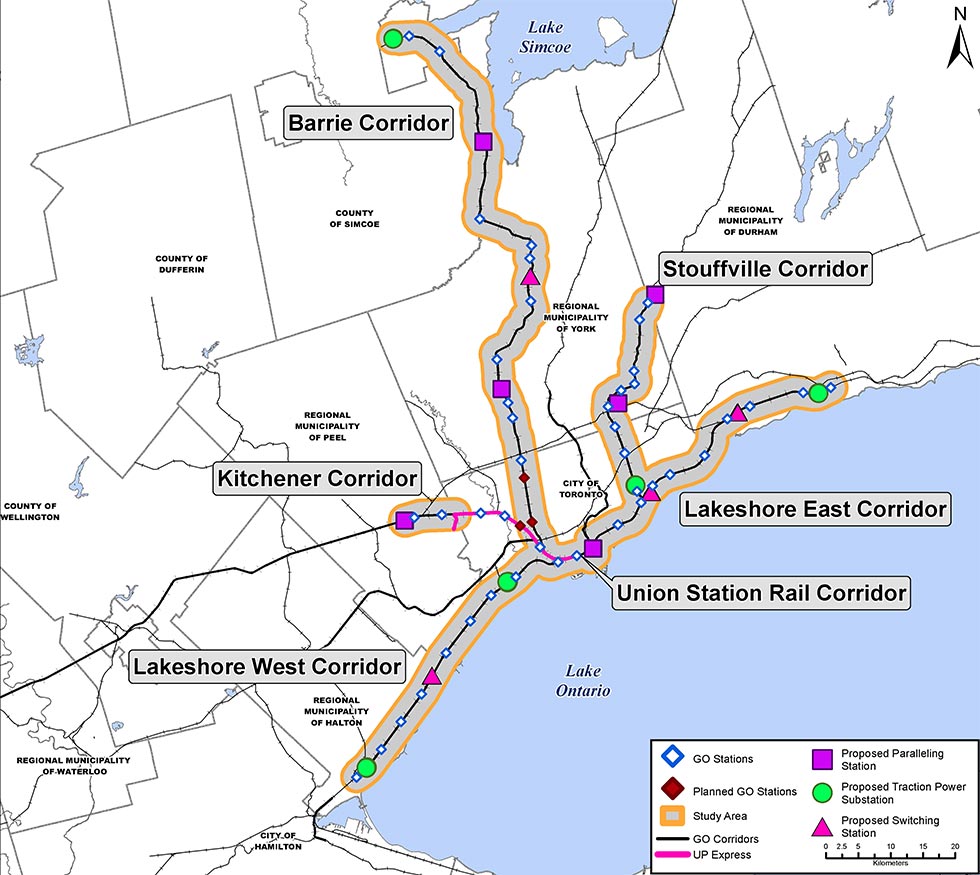Guest post by CodeRedTO volunteer Thomas Dybowski
With a goal of improving regional transportation in Ontario, Metrolinx has introduced the GO Transit Electrification project which focuses on upgrading the GO rail system throughout the entire Greater Toronto and Hamilton Area (GTHA). The electrification process consists of transitioning away from presently diesel-powered GO trains towards the use of direct electrical supply as a new power source.
Some of the benefits offered by the electrification process include a rail system which has improved speed while also offering services in a wait time of 15 minutes or less. This includes fewer interruptions in addition to travel being enabled both ways throughout the entire day. In addition to the improvements, a potential development of 12 new stations may take place across the region, including 8 new locations in Toronto which would serve towards improving commuter access and convenience. These positive attributes may also serve as a way of mitigating some of the effects of congestion in cities by offering alternative travel choices. Additionally, electrification directly benefits the city’s environment and health through improvements towards air quality as a result of lower emissions being produced.
Proposed electrification of corridors in the GO rail network [Source]
Additionally, on June 15 the Ontario Government has introduced another option, of using hydrogen as a potential fuel source, describing it as a potential alternative based on its popular use in other metropolitan areas of the world. Hydrogen is explained as a safe and clean alternative which serves as an improvement from current practices towards both people’s and the environment’s health. With a goal of selecting the best course of action when improving the GO rail system, consideration for the use of hydrogen as a potential source will continue during the electrification project. Studies will continue to explore the source and its benefits in the later months of 2017.
Currently, the project is in the Transit Project Assessment Process (TPAP) which identifies the impact different aspects of developing the project may have through its development, while also focusing on implementing technical approaches to provide solutions towards issues. A series of 28 public meetings have already been held in the Greater Toronto and Hamilton Area (GTHA) and are entering into their third round of discussions. This involves two phases already taking place during 2016 which focused on the different physical requirements associated with implementing the changes and the influence these changes may have on the local environment. Presently, consultations are in their third phase of the TPAP, which basis a review of all the information already heard from the public as well as more feedback with the purpose of generating an Environmental Project Review (EPR) which will then undergo public review.
To accommodate the Go Transit Expansion, additional implementation of infrastructure such as barriers would be used to shield areas which are visually impacted by the project, while also providing greater pedestrian safety from the rail system in places such as overhead crossings. Additionally, the project involves replacing bridges which are unfit for the new infrastructure, which would undergo construction to accommodate the necessary height clearance and barrier designs.
Some frequent issues discussed by the public involve the concern over the requirement of clearing a 7-meter distance of vegetation from the rail corridor, which intends to prevent any hazards towards the rail system. This includes problems which arise from the required removal of trees from resident’s private properties. Additionally, a frequent point of discussion involves the noise and vibration coming from the electrified trains, including issues with the train’s impact on people’s livability; especially in areas where corridors pass residential areas. One possible strategy proposed involves the use of 5-meter tall walls as shields to prevent noise disruption coming from the trains.
The project’s next steps involve focusing on completing the study by the end of 2017, which includes a public review from October to November and a review by the Minister until December. The goal of the project is to complete the construction process by 2025, whereby then service would become publicly available. The GO Transit Expansion will transform how rail systems operate in Ontario, with electrification working towards creating an improved transportation system for the years to come.
Thomas Dybowski is a student at the University of Toronto in the Urban Geography and City Studies program.
